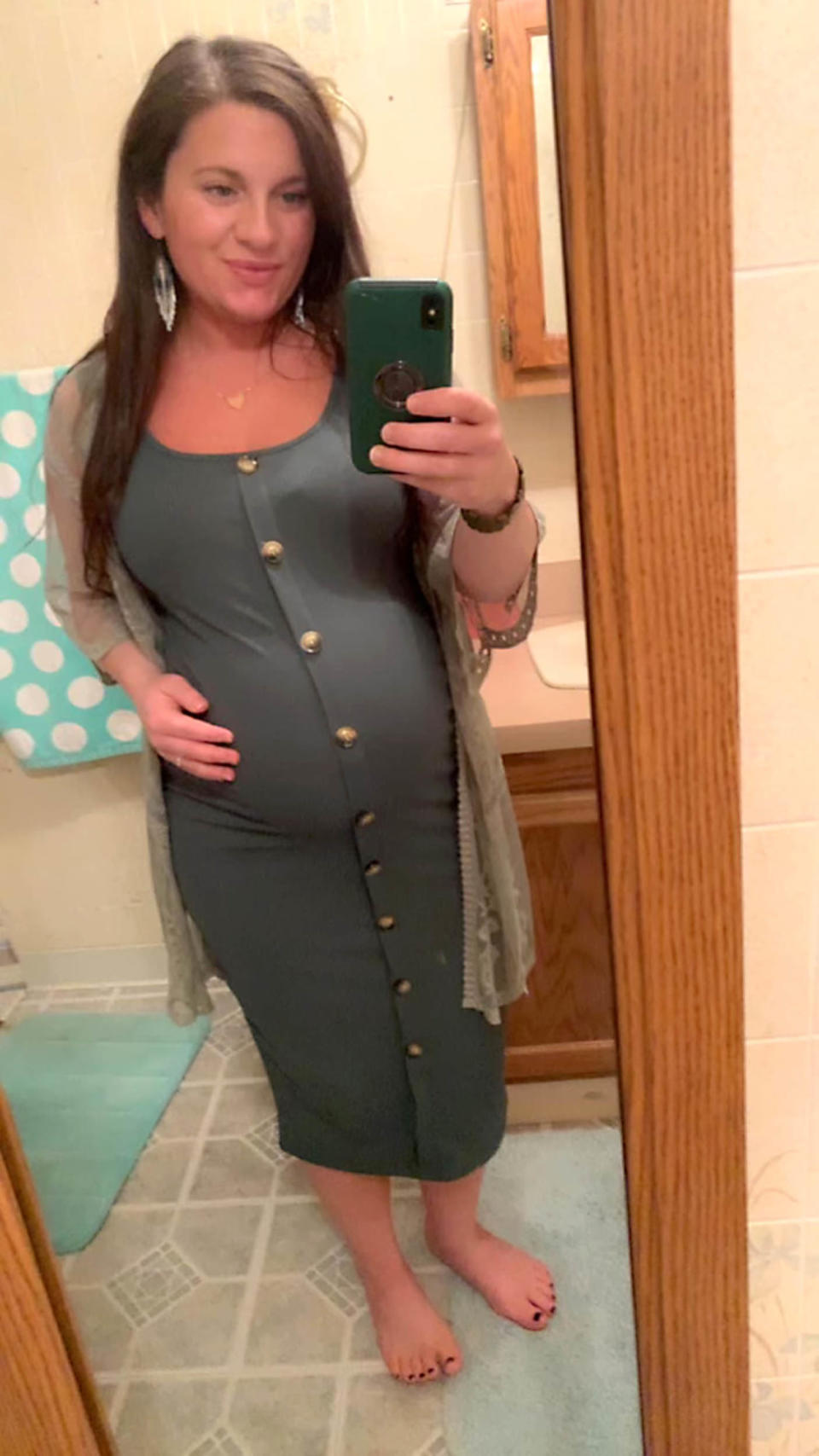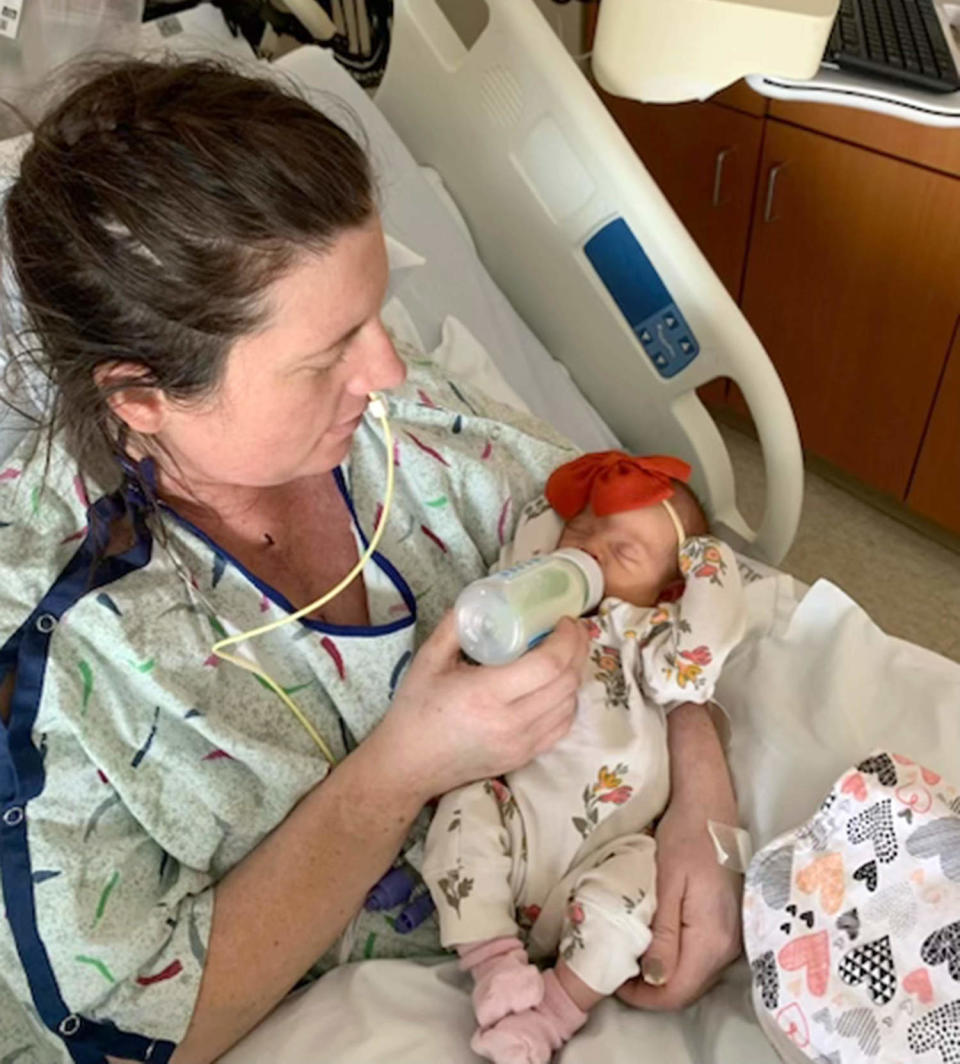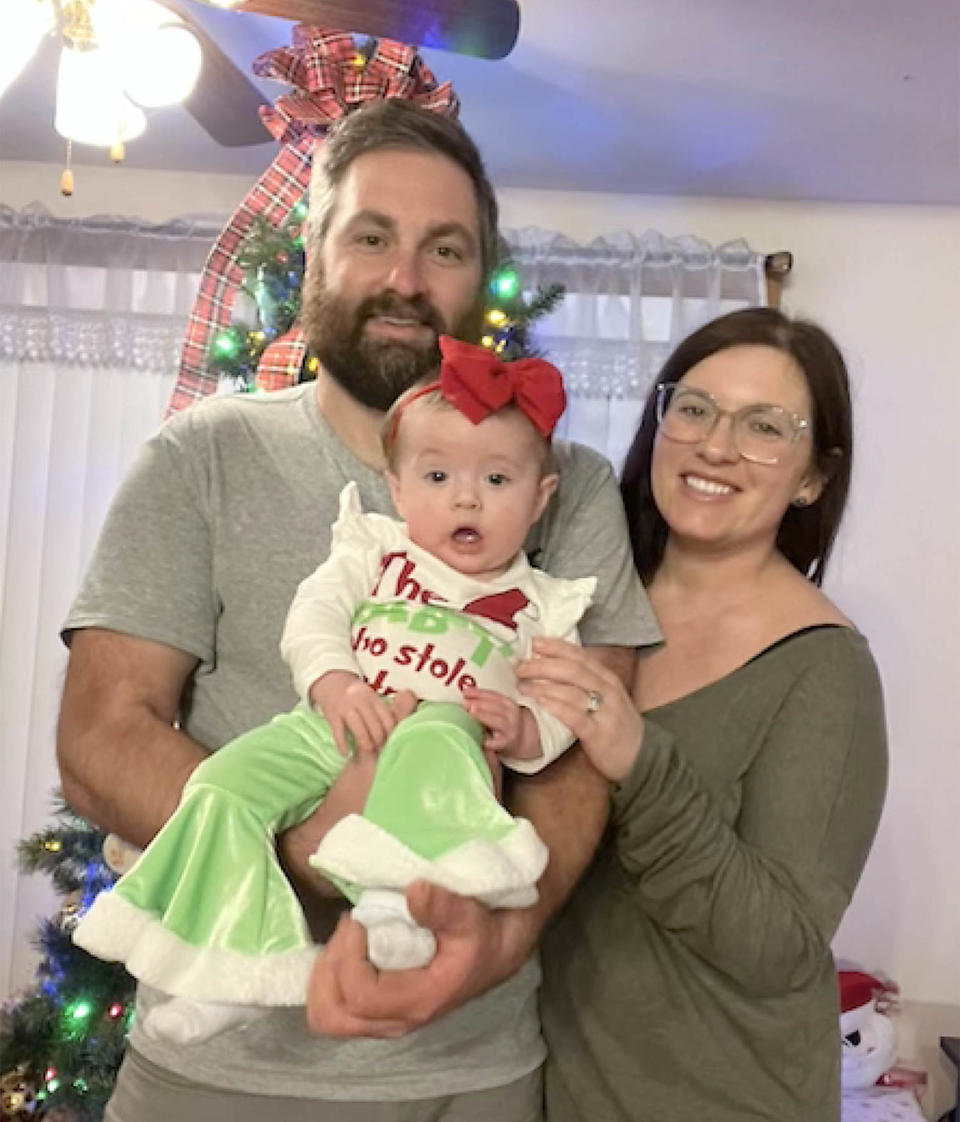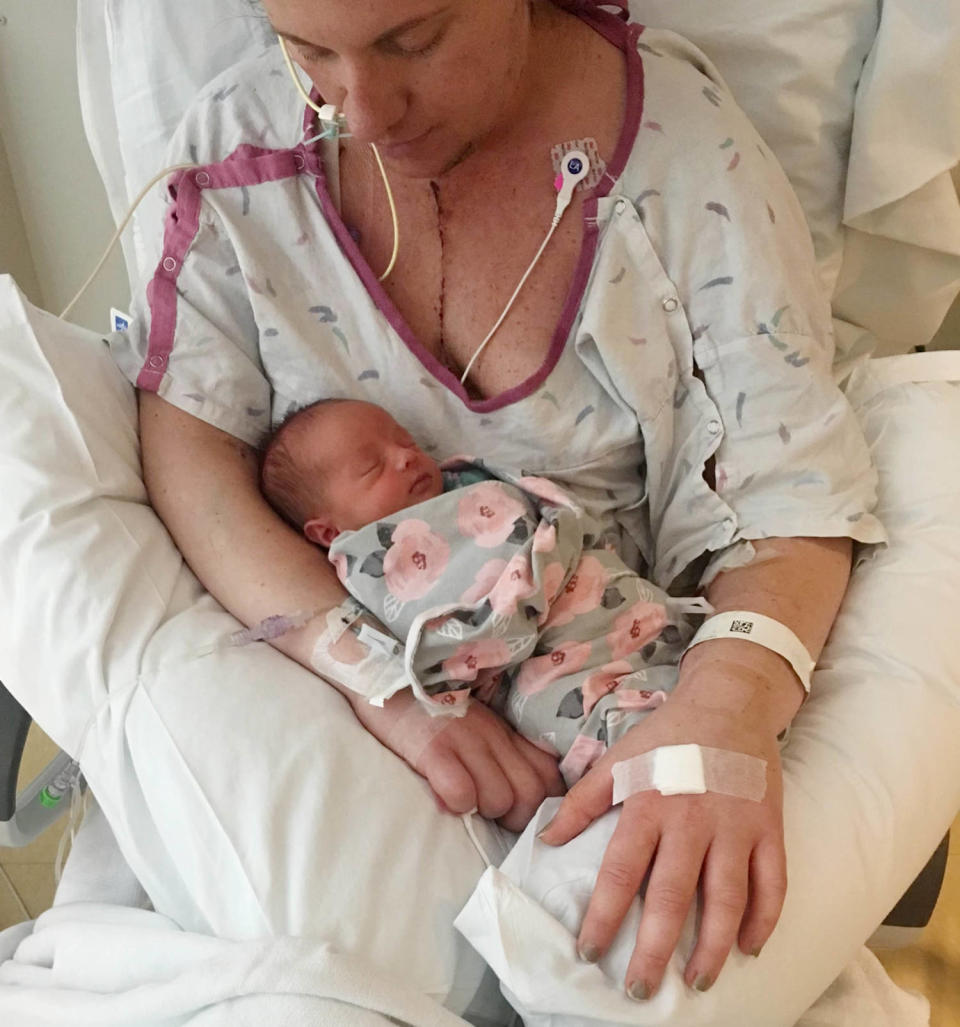Mom-to-be’s severe chest pain dismissed as panic attack. It was a near-fatal heart condition
- Oops!Something went wrong.Please try again later.
In early May 2023, a 35-week pregnant Amanda Banic visited the hospital with chest pain. Doctors told her she was experiencing indigestion and a panic attack — and sent her home. A week later, the pain returned.
“The only thing I can compare it to is a knife shredding through me,” Banic, 35, of Hartford, Michigan, tells TODAY.com. “I’m like, ‘This is it. I’m dying.’ This time the pain (radiated) up into my jaw. It’s this sensation I can’t really describe. My vision (started) to blur. I started seeing black.”

Terrified, her husband, Derek, urged her to return to the hospital. She felt wary because they already dismissed her.
“I’m like, ‘I’m not going to go to the hospital because they’re just going to send me away with anxiety,’” she recalls. “I felt like at that point I was going to be made a mockery of.”
Derek Banic insisted they go, and it saved his wife's life. She had an aortic dissection, meaning her aorta — the largest blood vessel in the body — was torn, a rare and often fatal condition.
“They’ve already told us that had we not went back to the hospital, I was within hours of passing,” she says. “It was overwhelming.”
A ‘beautiful’ pregnancy
Amanda Banic felt excited about her first pregnancy and welcoming a new baby. For 34 weeks, she experienced a “beautiful, very healthy pregnancy.” Then one day she felt a jolt of chest pain, and the couple rushed to the hospital. Doctors told her was fine.
“They had sent me away with anxiety and indigestion,” she says. “That whole week I just kept declining.”
A week later, she remembers feeling “very uncomfortable” and tossing and turning in bed. Since her first hospital visit, she had gained 20 pounds.
“I had been retaining all that water, barely able to breathe and absolutely miserable,” she says.
She decided to take a shower, hoping the warm water would soothe her.
“I was in there just a couple of minutes, and within that timeframe those same chest pains (came) back to me,” Amanda Banic says. “(They were) absolutely unbearable.”
When her husband saw her, he knew immediately they had to go to the hospital. But she hesitated to return.
“I felt foolish,” she says. “I’ve never been pregnant before obviously. I’m like, ‘Maybe pregnancy really is this miserable.’”
Derek Banic insisted, and within minutes of being in the emergency room, Amanda Banic was wheeled back for a CT scan. A relative of the couple was working in that hospital that day and urged the technician to complete a second, deeper scan.
“She told them ... ‘If it is a heart problem, she could die,’” Amanda Banic recalls.
Eventually the doctor agreed after learning about Amanda Banic’s family history of Marfan syndrome, a genetic condition that can cause heart problems, including aortic dissection, according to the Marfan Foundation. They conducted a second CT scan and discovered that her aorta was dissected.
“My room was filled with doctors,” she says. “I know something was wrong.”

The doctors said the mom-to-be would need to take a medical flight to Grand Rapids, Michigan, for an emergency treatment.
“(They said), ‘You’re going to have a heart procedure, and you’re going to have your baby,’” Amanda Banic remembers. “I still didn’t even know how serious this was.”
Delivery and emergency open-heart surgery
As a cardiothoracic surgeon, Dr. Stephane Leung has treated several patients with aortic dissection, even though it’s rare. It occurs so infrequently during pregnancy that few doctors have experience managing situations like the Banics'. As he waited for his patient to arrive at Corewell Health in Grand Rapids, Michigan, he read the handful of cases studies on aortic dissection in pregnant people.
“No center does a lot of these, thankfully,” Leung tells TODAY.com. “Usually, our protocol here is to go straight to the operating room, but in her case, obviously, we had a baby, which made things a bit more challenging.”
Leung knew he’d need to work in tandem with the fetal-maternal medicine department. Immediately, he placed Amanda Banic on a heart-lung bypass machine, which takes over for the heart and lungs during surgery, while Dr. Erin Fricke, a high-risk obstetrician, performed an ultrasound to make sure the baby’s health was stable. As soon as Leung finished, Fricke performed a cesarean section.
“I asked her if she was having a boy or a girl, and she told me it was a girl. And I asked what the baby’s name was,” Fricke, a maternal-fetal medicine doctor at Corewell, tells TODAY.com. “It’s such a huge moment in her life that I didn’t want to ignore the importance of this being the birth of her child.”
While the delivery on May 9, 2023, went off without a hitch, Banic was at risk of hemorrhaging afterward. That’s because blood flow increases when a person gives birth, and she was taking blood thinners in order to be on the bypass machine, which prevent blood from clotting.
“We put a balloon inside her uterus to put pressure on the blood vessels so that she hopefully would not experience an excessive amount of bleeding,” Fricke says. “That tool helped us to a great degree to keep her bleeding and her uterus stable during the cardiac surgery.”

Then Leung started his surgery.
The aorta is shaped like a cane, starting in the lower-left chamber of the heart up, extending up a little bit before curving back down into the belly and branching off into the legs. Amanda Banic’s “entire aorta was dissected,” Leung says.
He did an emergency open-heart procedure to fix the aorta in the chest. When he tried weaning her off the heart-lung bypass machine, she struggled, so he needed to do another procedure to replace some arteries to improve blood flow. After surgery, he placed her on ECMO — a machine that removes carbon dioxide and sends blood with oxygen in it back into the body — to “allow her heart and lungs to rest” while she recovered in the ICU.
“Within two or three days, she completely recovered, which I would say is nothing short of a miracle,” Leung says.
The dissection was extensive, and he was unable to close the entire tear. Leung will monitor Amanda Banic’s aorta with CT scans to make sure she’s not at risk for complications. While the aorta can repair some on its own, it is possible she could need surgery again. Still, she can enjoy a mostly normal life.
“(She needs) good blood pressure control, and we say no heavy lifting and only because heavy lifting increases your blood pressure,” Leung says. “Those are basically the only restrictions, but otherwise she should be able to live a completely normal life.”
‘Making the most of life’
Every day, Amanda Banic feels stronger. She enjoys spending time with her daughter, Baylor. The family took a vacation where they hiked and visited waterfalls. While she feels better, she sometimes struggles to breathe and often feels tired.
“We are really making the most of life and not taking a single thing for granted and doing every single little thing we can together, making the most memories possible,” she says.
It’s likely too dangerous for Amanda Banic to be pregnant again. Since her surgery, she's been diagnosed with Loeys-Dietz syndrome, a connective tissue disorder that can cause aortic aneurysm or dissection, according to Penn Medicine.
Her faith in God helps her grapple with her ongoing health challenges. When she looks back at the last days of her pregnancy, she feels stunned.
“I was within hours of passing, and my husband was within hours of losing his wife and baby. It’s devastating to me. It’s such a heartbreaking thought,” she says. “It takes my breath away.”

During physical, occupational and speech therapy, the new mom worked hard to talk and walk because of Baylor. She credits the skin-to-skin contact she received while in the ICU with saving her.
“The only times I would really react or show signs of life is when they would do skin to skin,” she says. “They would put Baylor on my chest, and I would cry or shed tears, and sometimes she would be crying and they would put her on me and she would stop crying and go right to sleep.”
Amanda Banic wanted to share her story to encourage others to seek help when they experience a health emergency
“It’s important that people listen to their body and reject the fear of what people may think of you,” she says. “You have to advocate for yourself.”
This article was originally published on TODAY.com

